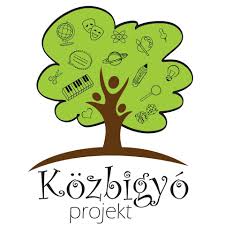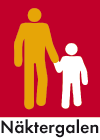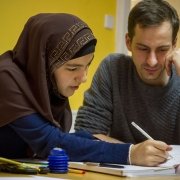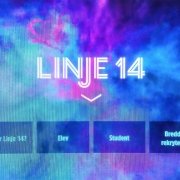Common Thingy (Közbigyó) – A Parent-Led Mentoring Programme
Excerpt
Common Thingy (Közbigyó) is a parent-initiated and parent-led programme in a primary school in Budapest that is aiming at developing skills and competences related to collaboration, flexibility, open communication, initiative and follow-through, problem solving by implementing small group projects in order to re-introduce self-control over learning, bringing the joy of learning back and developing learning-to-learn competences for lifelong learning for both children and their parents.
Narrative, origins and objectives of the initiative
What kind of project is this? Please give a short description (summary) of it.
Common Thingy (Közbigyó) is implemented in a state school in a suburban district of Budapest. A small group of parents initiated the project, asking permission from the school to introduce the programme to enhance collaboration between parents, teachers and students. Collaboration of the teachers mostly involves recruiting participants and providing an opportunity for the projects to show their results to everybody in the school. The programme is implemented on a voluntary basis – by both mentor parents and students volunteering to participate - in both lower and upper primary classes. Children work in self-initiated groups of 4-5 persons, with the support of a parent mentor to each group. The projects produced in the programme’s framework are focusing on an area close to children’s lives but neglected by national curriculum, any area of their own interest. The project outcomes vary and have included performances, videos, animations, board games, health food offered to peer, exhibitions, jewellery, and many more. Some of the project's products can be seen on the website here: http://www.kozbigyo.hu/alkotasok/?fbclid=IwAR0nF1DfXkkQ6QLEkU1gLPJeEcFYKslLEyAGY8xUvdzgTJ9d1_x6SEmmH5E In some instances, projects were focused on health and well-being, as well as on sustainability. More than half of the students of the school participate in the programme. The aim was to show an alternative to the generally rigid, traditional, content-focused school activities that also develop soft skills, for children to experience self-directed learning, and also to make it possible for parents to experience that new ways of learning might be more effective than traditional, parent-controlled homework and preparation for lessons. Common Thingy is an inclusive education programme for both children and parents, also supporting parents in their lifelong learning. It enables parents with low levels of education to become role models for their children in learning.
Please tell us why, in general, this project is considered a successful one?
The programme has been running for 3 semesters only, but the number of participants has grown exponentially. Parents report that children use techniques and learning strategies acquired through the programme in other situations too. The programme also resulted in much better communication among and between major stakeholder groups of the school (children, parents and teachers). The programme also supported community building in school and class as a number of previously excluded children, but also many parents managed to reposition themselves in class communities. Also, excluded parents became well-established members of the school community.
And why would you consider it a grass-roots initiative?
The initiative was started and developed from scratch by 3 parents of the school.
What challenges needed to be solved in this project?
The main challenge was to break the initial resistance of teachers. This was supported by two teachers who had had an exceptionally open attitude towards parental initiatives. By now the majority of the teaching staff is supportive of the project and the others are also more neutral than hostile. This is mostly due to the project resulting in better learning outcomes and less problems in class, as well as more collaborative parents and children.
This resistance was partly a result of the school having an already good reputation in the district and it was therefore difficult for some teachers to see why it is beneficial to innovate if they are already ‘good’ and have more application requests than other schools.
Experience also shows that execution can go off track if teachers and mentor parents do not embrace the ethos of the programme: to celebrate children for what they are good at and give them the autonomy to implement their group projects.
Using Facebook as the primary platform to introduce and coordinate projects may also introduce challenges re: the “right, safe, clever” usage of social media to assist cooperation and learning.
Is this initiative based on any particular theoretical framework? Which one?
The initiators based their programme on the theory of Ryan Eliason on success. The inspiration came from a similar programme implemented in Finland and disseminated by Finnagora, the Finnish National Cultural Institute. It uses basic project methodology and Working on What Works (WOWW), a solution-orientated approach to build on personal strengths.
(Appendix) Is your intervention standing on its own or is it a part of a bigger and more holistic approach?
It is a stand-alone initiative, but it is embedded in a school climate that is more open to parental engagement than national average.
Please describe the group(s) intended as beneficiaries of this initiative
Why has this group (have these groups) been chosen?
Parents wanted to support their own children as well as other children in the school. School-aged children in Hungary suffer from a more rigid, academic-content oriented school system since 2012 that also means a heavy workload of too many lessons and compulsory homework. The programme is targeting those parents who realize that school as it is now, is not beneficial for their children, but have not yet given up hope that it can be changed.
Could you please tell us something about the relative size of the (of each) target group, within the school/university population, region and/or country?
The school itself has 500 students in total with a total of about the same number of parents, but the programme could easily be implemented in any other school, so the total target group could be 3-4 million.
Which social characteristics are taken into account and what is the geographical area covered?
The geographic area covered is a suburban district of Budapest where the local population is diverse. The school mirrors the local population with children from both very high and very low SES, as well as a high percentage of lower middle class.
On which level is the project implemented?
School level
Please describe the political and socio-economic factors that you believe have been important enablers for your initiative
Did the initiative have political support?
As Hungary is implementing a relatively newly introduced, very traditional approach to schooling and education policy openly supports segregation rather than inclusion, political support is not a given.
How did it fit with local, regional or national policies?
It does not fit any policy trends on these levels.
Who are the stakeholders supporting the initiative?
The most important stakeholders are parents, but the supportive attitude of teachers is a necessity for long-term success. In an ideal case school leadership is also committed to the programme, but their non-hostile attitude is a must.
Are there particular demographic changes present that are influencing the project?
There is an increasing trend in Hungary for concerned parents to take their children out of the school system by either emigrating or establishing their own schools, or home-schooling arrangements. However, the long-term effect of these actions are not yet apparent, and some examples show this might not lead to a successful return to formal education when they are older. This programme, however, aims at improving the state education system from within.
What is the institutional strategy and culture of the (educational) organization?
Institutional strategy on school level has been based on national standard requirements, but also on a certain level of competition with other schools in the area. Some teachers traditionally had a collaborative and pro-active approach to parents, and the general approach towards parents was at least not hostile.
To what extent does the initiative have an influence on institutional policy (or potential influence) of the (educational) organization?
The programme has already had an effect on institutional culture. Most importantly, internal communication & collaboration have improved substantially. The participants hope that on the long run it will change teaching and learning strategies in general, and may even be incorporated in the local curriculum.
(Appendix) Is there public support for your initiative and the issue it addresses?
As most parents and the general public currently see Hungarian schools as something not suitable for children and most probably not preparing them for a successful and happy adult life, public support can be assumed.
(Appendix) What other factors do you think have been important for the success of this initiative?
Nothing else in particular.
Please describe the overall initiative design and the methods and tools used to reach the goals
Please describe the specific activities carried out.
To establish the programme, the initiators made a detailed project plan and approached two teachers to help them implement the programme in the school and to win the approval of the school’s leadership for it. Once this openness was ensured, implementation could start. First, teachers are introduced to the goals and logistics (steps and timeline) of the programme.
Preparation of a programme cycle is two-folded: one leg is to recruit and train mentor parents by the organizers (parents, with the support of teachers if possible), the other is to recruit and group children. Training of the mentors entails when they are introduced the ethos of the programme & basics of project mentoring. A recommendation is made that they follow the 4 key steps (planning sheet, implementation and visual documentation, evaluation sheet, preparing for the presentation). The most important element of the training is to prepare mentor parents for not intervening if not absolutely necessary.
The project teams are formed by the children themselves, which is usually at rare occasions when their teacher persuades them to take an extra person on board who was not included by any of the groups. Mentor parents usually work with groups that do not include their own children.
Mentors and project teams meet 3-4 times for 3-4 hours each time to prepare their project, using the 4-step implementation plan. Once the project is ready they submit it to the organisers. At the end of the programme cycle there is an opportunity for all projects to present themselves in front of an audience of other project teams, children who have not participated in the programme, teachers and parents. This has triggered more participation, but the main role is to appraise their work in a non-competitive environment and encourage peer-to-peer learning and appreciation for each other among the children. All participants receive a “diploma” that certifies the project they completed and the things exceeded with. Fifth, a party of celebration is held for mentor parents and teachers where individual experiences, recommendations, possible pitfalls, etc. can be discussed in a laid-back environment.
What were the key roles (teacher, student, management team etc.) within the project?
School leadership: making it possible to organise the programme and offering space and time for the final event of each programme cycle.
Teachers: helping to inform all parents and children about the programme, participating in forming the project teams.
Students: they are planning, executing and evaluating their own projects from choosing a topic to what methodology to use, to showing it to their peers, parents and teachers at the final gala of the project cycles.
Parents: acting as mentors and mentor trainers, liaising with teachers.
What ideas, tools, theories, models, methodology (etc.) have been used to reach the goals?
Project methodology
Valuing knowledge not traditionally validated by school
WOWW
Mentoring models
What are the final revenues of the project?
The approach seems to be more beneficial for those children who have higher levels of autonomy. In many cases it helped children to have better learning outcomes - even in cases when their teacher’s pedagogical methodology has some limitations. It also helped parents to understand that their children learn better if they are given responsibility for their own learning rather than the parent watching their learning at home and doing homework very closely. It also boosts the confidence of parents who are considered less successful by their peers as mentoring does not require traditional, academic knowledge. It also helps parents to understand the complexity of school more as they don’t only see school via their own children. For the teachers the programme results in stronger class communities as well as more cooperative children and parents. The self-esteem of children with low SES among their peers has grown and they now get more support from them, which resulted in an upward spiral in their schooling in some cases.
Please describe if your project ensured its sustainability
If so, how did you ensure the short-term impact of the project?
By working closely together with mentor parents as well as teachers, highlighting all achievements and evaluating each programme cycle with teachers and parents.
And how did you ensure the long-term impact of the project?
Some of the organisers would like to see the programme to be part of the official pedagogical programme of the school, but all of them agree that, for a long-term impact on each generation of children, it is necessary for them to participate in several project cycles in different roles, using a variety of skills, methods and techniques.
According to the organisers a long-term impact is ensured systematically documenting all activities within the programme, involving parents who have more than one children attending the same school or starting school in years to come. The organisers are also on the lookout to ensure their successors. Support from teachers and the school head is also crucial for sustainability. If children enjoy participating in the programme, they also anticipate and demand a next cycle. Parents are also willing to participate in a programme that their children like and enjoy, thus making the programme self-sustaining.
Has your project been replicated elsewhere?
They have developed a fully adaptable and implementable methodology available for any school, and two other primary shools in Hungary have already had their first programme cycle with 5-10 project groups each. These schools are dedicated to continue with new cycles and with a greater number of participants.
Please tell us about the resources used in this initiative
What was the budget for the initiative?
The programme has been implemented without an explicit budget that most probably helped creativity to strive. Basic technology for e.g. film projects has been available at the participating families. Some projects had a cost of 10-20 Euros provided by the families. The programme is built on volunteers’ time contribution, the value of that has not been calculated.
How much did the initiative depend on volunteers?
The initiative fully depends on volunteers, but supply is present for any number of new cycles since they are building on parents volunteering.
To be sustainable, 2-3 parents must be are available, with flexible work arrangements, to organise the implementation of the programme.
How were the costs perceived by the public/the sector/other stakeholders?
This question is not really applicable, but it can be said that the minimal costs were covered by parents of participating children without any complaints.
To what extent did the initiative achieve its objectives?
Please describe the evidence to support the success of your initiative.
One evidence is the growing interest in the programme by both children and parents, and a growing number volunteers offering their help as mentors.
Another evidence is increasing school success and stronger bonds among children, but also among the whole triangle of key education stakeholders: children, parents and teachers.
The initiative and the teachers supporting it were also awarded the Varga Gábor Prize for teachers championing in engaging parents in school.
Did the intervention lead to any unintended (positive) outcomes?
The fact that parents became co-educators by mentoring groups of children made them feel more confident and comfortable to approach teachers and attend school regularly. As project meetings usually took place at the home of mentor parents, it also offered an opportunity for children and other parents to learn more about others’ lives.
What indicators (quantitative and qualitative) have you measured to demonstrate success?
- number of projects plus number of classes, children, and mentor parents involved
- quality of project according to teachers and mentors
- feedback given by children, their parents, mentor parents and teachers on the evaluation sheets, at the party, and the website/Facebook page of the programme.
(Appendix) How did you evaluate/monitor this intervention?
The mentor trainers are available to support other mentors throughout the programme cycles, before and during the projects’ development. At the end of each cycle mentors and supportive teachers, together with the school head, evaluate the cycle. The most important moment of evaluation, at the end of each cycle, is the final opportunity to show the projects’ outcomes to other children. It is done in a non-competitive way.


 Copyright by Mili Flener
Copyright by Mili Flener Interkulturelles Mentoring
Interkulturelles Mentoring


 Sale für Alle 2018
Sale für Alle 2018

